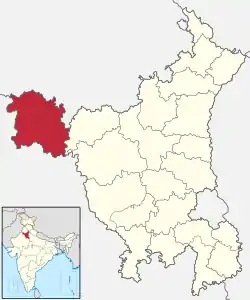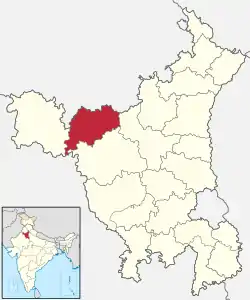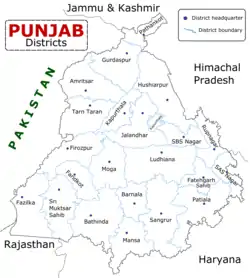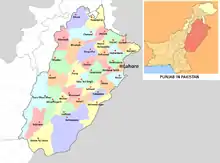Bagri language
The Bagri language (बागड़ी) forms something of a dialect bridge between Haryanvi, Rajasthani, and Punjabi and takes its name from the Bagar tract region of Northwestern India.[3] The speakers are mostly in India, with pockets in the Bahawalpur and Bahawalnagar districts of the Punjab in Pakistan.
| Bagri | |
|---|---|
| बागड़ी | |
| Native to | India |
| Region | Bagar |
| Ethnicity | Bagri |
Native speakers | 1,890,815 (2011 census)[1] 2001 Census 2,081,044 speakers of Bagri Rajasthani and Punjabi Bagri.[2] |
Indo-European
| |
| Devanagari | |
| Language codes | |
| ISO 639-3 | bgq |
| Glottolog | bagr1243 |
Bagri is a typical Indo-Aryan language akin to Haryanvi, with SOV word order. The most striking phonological feature of Bagri is the presence of three lexical tones: high, mid and low, akin to Punjabi.[4] The language has a very high (65%) lexical similarity with Haryanvi. According to the 2011 Census, there are 234,227 speakers of Bagri Rajasthani and 1,656,588 speakers of Punjabi Bagri.[5]
Features
Phonology
Bagri distinguishes 31 consonants including a retroflex series, 10 vowels, 2 diphthongs and 3 tones.
Declension
- There are two numbers: singular and plural.
- Two genders: masculine and feminine.
- Three cases: simple, oblique, and vocative. Case marking is partly inflectional and partly postpositional.
- Nouns are declined according to their final segments.
- All pronouns are inflected for number and case but gender is distinguished only in the third person singular pronouns.
- The third person pronouns are distinguished on the proximity/remoteness dimension in each gender.
- Adjectives are of two types: either ending in /-o/ or not.
- Cardinal numbers up to ten are inflected.
- Both present and past participles function as adjectives.
Verbs
- There are three tenses and four moods.
Syntax
- Sentence types are of traditional nature.
- Coordination and subordination are very important in complex sentences.
- Parallel lexicon are existing and are very important from sociolinguistic point of view.
Samples
| Bagri | Transliteration | Translation |
|---|---|---|
| तेरो नाम के है | Tero nām ke hai | What is your name? |
| किन्नै जावै है? | kinne jāve hai | Where are you going? |
| इन्नै आ | inne ā | Come here |
| क्यूकर है ? | kyūkara hai | How are you? |
| टींगर टीटणं नां मार | ṭīṅgar ṭīṭaṇ nā mār | Hey kid! Don't waste our time. |
| तन्नै कुचरणीं ही करनी है के ? | tannai kučaraṇīṃ hī karni hai ke | Do you only want to disturb things? |
| बातां गा पीसा लागै है. | bātāṃ gā pīsā lāgai | Talking costs money. |
| मुंह करै जिया बताऊ जिसों या मुंह करै बताऊ बरगो | Munh kara jiyā batāū jiso or Munh kara Batāū bargo | Your face looks like eggplant. |
| क्यांमी राफ चोड़ी करै है रे? | kyāmī rāpha čoṛī karai hai re | Why are you making your mouth as that of a moron? |
| के करे है? | ke kare ha | What are you doing? |
| रोल्लो है के कोई तेरै | rollo ha ke koī terai | you have any problem |
| तू कठै गयैड़ो हो | too kathai gayairo ho | Where did you go? |
| कठैउं आन लाग रह्यो है? | kaṭhū ān lāga rahyo ha | Where are you coming from? |
| भांडा | bhanda | Utensils. |
| घोड़ो होव जिओं | Ghodo hov jiya | like a horse |
| कोजवाड़ | kojwād | embarrassing. |
Work on Bagri
- Grierson, G. A. 1908. (Reprint 1968). Linguistic Survey of India. Volume IX, Part II. New Delhi: Motilal Banarasidass
- Gusain, Lakhan. 1994. Reflexives in Bagri. M.Phil. dissertation. New Delhi: Jawaharlal Nehru University
- Gusain, Lakhan. 1999. A Descriptive Grammar of Bagri. Ph.D. dissertation. New Delhi: Jawaharlal Nehru University
- Gusain, Lakhan. 2000a. Limitations of Literacy in Bagri. Nicholas Ostler & Blair Rudes (eds.). Endangered Languages and Literacy. Proceedings of the Fourth FEL Conference. University of North Carolina, Charlotte, 21–24 September 2000
- Gusain, Lakhan. 2000b. Bagri Grammar. Munich: Lincom Europa (Languages of the World/Materials, 384)
- Gusain, Lakhan. 2008. Bagri Learners' Reference Grammar. Ann Arbor, Michigan: Northside Publishers
- Wilson, J. 1883. Sirsa Settlement Report. Chandigarh: Government Press
Gallery
Regions where Bagri is spoken:
 Bagri is the First language in Sirsa district.
Bagri is the First language in Sirsa district. Bagri is the First language in western Fatehabad district.
Bagri is the First language in western Fatehabad district. Bagri is the First language of Ganganagar district, Hanumangarh district, north-western part of Churu district and a major language in north-western part of Jhunjhunu district in Rajasthan.
Bagri is the First language of Ganganagar district, Hanumangarh district, north-western part of Churu district and a major language in north-western part of Jhunjhunu district in Rajasthan. Bagri is the major language in Fazilka district and as a minor language in southern villages of Muktsar district of Southern Punjab (India).
Bagri is the major language in Fazilka district and as a minor language in southern villages of Muktsar district of Southern Punjab (India). Bagri is a minor language is spoken in Bahawalpur and Bahawalnagar district of Punjab, Pakistan, though not considered parts of Bagar tract.
Bagri is a minor language is spoken in Bahawalpur and Bahawalnagar district of Punjab, Pakistan, though not considered parts of Bagar tract.
See also
- Rajasthani language
- List of winners of Sahitya Akademi Awards for writing in Rajasthani language
- List of Rajasthani poets
- List of Indian poets#Rajasthani
References
- "Statement 1: Abstract of speakers' strength of languages and mother tongues - 2011". www.censusindia.gov.in. Office of the Registrar General & Census Commissioner, India. Retrieved 7 July 2018.
- Census India 2001
- "Revised Land and Revenue Settlement of Hisar District 9006-9011" (PDF). Archived from the original (PDF) on 17 May 2017. Retrieved 26 March 2016.
- Gusain 2000, p. 14.
- Census of India 2011
Bibliography
- Gusain, Lakhan (1999). A Descriptive Grammar of Bagri (PhD). Jawaharlal Nehru University. hdl:10603/16847.CS1 maint: ref=harv (link)
- Gusain, Lakhan (2000). Bagri. Languages of the world. Materials. Munich: LINCOM Europa. ISBN 978-3-89586-398-1.CS1 maint: ref=harv (link)